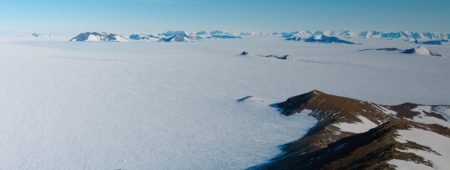
Searching for Climate Answers

As our climate changes, global temperatures are rising, and massive ice sheets in Greenland and Antarctica are shrinking.
If temperatures continue to rise, it is possible that the melting of these ice sheets will eventually spew enough water into the ocean to raise the sea level by two to 10 feet. Even as little as three feet of sea level rise would swamp coastal areas, causing flooding and displacing close to a billion people.
Scientists around the world are scrambling to predict the amount and timing of sea level rise using computational models. But their estimates work best if they can cross-check their predictions against real, historical ice sheet behavior. Collecting this data can be tough in Antarctica, the coldest, windiest, and highest continent on Earth.
Hertz Fellow Greg Balco, a geochronologist at the Berkeley Geochronology Center, has visited the Antarctic ice multiple times. He's part of an international group of scientists piecing together how glaciers behaved during warm periods similar to today’s climate. His group drills for rock samples from both sides of the glacier to look for clues about its recent past.
“There are a number of periods in the last few million years when atmospheric carbon dioxide and temperatures were similar to today,” says Balco. “We're trying to find out what the ice looked like at those times.”
His target is Thwaites Glacier, a Florida-sized block of ice on the edge of the West Antarctic Ice Sheet. This fast moving, unstable glacier loses about 100 billion tons of ice each year. Thwaites Glacier alone contains enough water to raise the sea level more than two feet. Its melting could also affect adjacent parts of the West Antarctic Ice sheet, which could add another several feet of sea level rise.
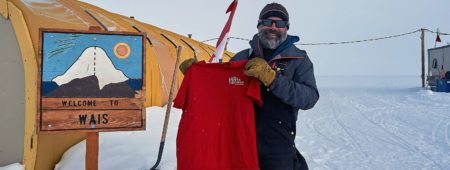
Miles from Anything
While rock drilling is routine under normal conditions, the extremes of the Antarctic environment pose unique challenges.
For instance, water is usually used to lubricate the drill and flush out any rock chips and debris from the drill hole. But in -40-degree Antarctic temperatures, using water is off the table. The team has developed a non-water fluid that won’t freeze under such harsh conditions. But this also requires keeping the hole as cold as possible.
“If you get anywhere near the freezing point, all kinds of bad things happen and you can get the drill stuck or lose it entirely,” says Balco.
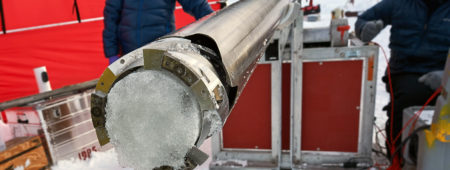
In addition, the team has to bring all of their own field gear, tents, and food supplies to the drill sites. They have their home base at McMurdo Research Station, a small city on the edge of the ice sheet, south of New Zealand. At McMurdo, the team loads up their gear to be shuttled by plane to the West Antarctic Ice Divide Station (WAIS). Gear lists are meticulous—it's not the time to forget the cookstove or drilling equipment.
At WAIS, the gear is moved onto smaller aircraft for travel to the field site on the glacier. This isn’t just a set of camping gear—everything the team needs for the next month must be carried by air, including maneuvering multiple snowmobiles into the cargo bays of small Twin Otter airplanes. Balco notes that each plane can carry about 2,000 lbs, so there are many plane shuttles back and forth to the field site.
Once on site, the team is truly isolated. Stretches of white ice and snow extend as far as the eye can see, punctuated by the errant mountains peeking above the glacier ice. Their nearest colleagues are at WAIS, a two-and-a-half hour flight away.
The small team bunks up two to a tent and has a communal kitchen tent. Despite the constant sunlight, the team sticks to eight-hour working shifts for safety and coordination with other scientists on the continent. Fieldwork usually lasts about one month; then the team packs up their campsite, plus their rock samples, and starts the long transfer back to WAIS, McMurdo, and eventually their home laboratories.
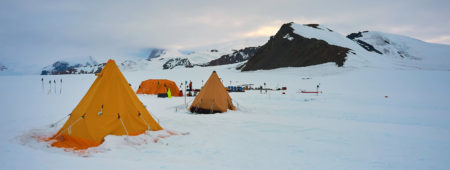
Clues under the Ice
Balco says that when he was a graduate student, the support from his Hertz Fellowship allowed him to study how rocks from unique and difficult places can each tell their own story.
The Earth’s surface is continually bombarded by so-called “cosmic rays,” high-energy particles that originate from sources in outer space and travel for vast distances at nearly the speed of light. When these cosmic ray particles hit rocks on Earth’s surface, they break apart atomic nuclei and produce rare isotopes like carbon-14 and beryllium-10. Balco uses measurements of these isotopes to determine how long rocks have been exposed to the cosmic ray flux at the Earth’s surface.
The rocks he is collecting at Thwaites Glacier are currently covered by ice, but in warmer times throughout history, those rocks may have been basking in the sun. If Balco and his colleagues can detect cosmic ray-produced isotopes in these samples, they can find out whether or not—and how much—the ice sheet shrank during these warm periods.
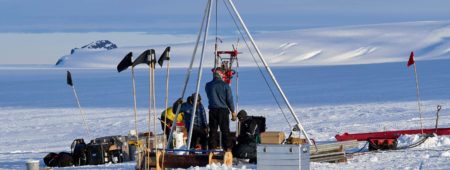
Some model simulations show the West Antarctic ice sheet completely collapsing in a warmer future, but that’s not a certainty. “The simulations show that it's physically possible, but we don't really have any evidence that it actually did happen in the past,” says Balco.
The data that Balco and his colleagues collect can narrow down all the possibilities that could happen to ice sheets with increasing temperatures. Geologic evidence showing what happened in the past acts as a reality check for predicted ice sheet behavior.
Balco’s research also helps calibrate complicated models. “If you have some kind of ice sheet model that’s supposed to predict what West Antarctica is going to do in the future, we’d really like to have some idea whether it successfully reproduces what West Antarctica did in the past,” he says.
For instance, if Balco’s research shows that the ice retreated at a certain time and temperature, does the model also show that same ice behavior? Geologic information can help tweak the many factors of a model, making it more accurate.
Thwaites Glacier is a key player in potential sea level rise, and the international team is working hard to better understand how it behaves. “What sea level is going to do in the future is really a question about what ice sheets are doing in the future,” said Balco.
It is still not clear if or when Thwaites Glacier might collapse, but researchers are hoping to provide better forecasts to hopefully give communities and policymakers enough time to prepare for a rising sea.

